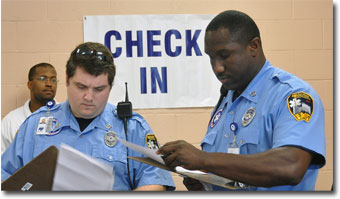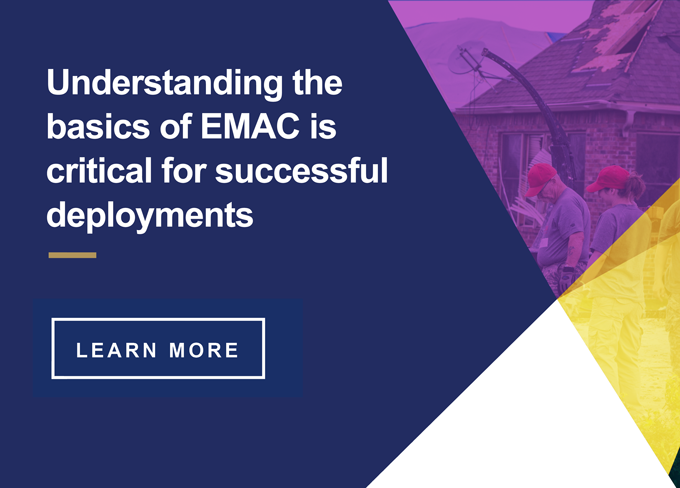Mission Ready Package Templates
In 2023, NEMA partnered with the International Association of Fire Chiefs (IAFC) to develop templates for the development of Mission Ready Packages (MRPs).
MRPs are key to expediting the mutual aid request and offer process and ensuring all mission related expenses are accounted for and paid during reimbursement.
Download a MRP template to build your own MRP today and upload it into the Mutual Aid Support System (MASS). Learn more about building an MRP.
MRPs are key to expediting the mutual aid request and offer process and ensuring all mission related expenses are accounted for and paid during reimbursement.
Download a MRP template to build your own MRP today and upload it into the Mutual Aid Support System (MASS). Learn more about building an MRP.
Learn How to Prepare for an EMAC EMS Mission
 Operational lessons learned from past EMS deployments:
Operational lessons learned from past EMS deployments:
As the Requesting State, when you bring in EMS resources, consider the following:
- The safety of the personnel and the equipment. You may need to request law enforcement to deploy in tandem with the EMS units. Be prepared for the Assisting State to include law enforcement resources in an EMS Mission Ready Package as standard practice.
- The EMS units must be secure and housed within a secure parameter when not in use.
- Lodging, meals, and facilities for personnel. Each site should have toilets, adequate plumbing, and the capability to provide onsite feeding or, at a minimum, host feeding resources for EMAC responders. Consider advanced planning with EMAC Shelter Unit, Base Camp, Red Cross, Salvation Army, Southern Baptist Disaster Relief, or other social service agencies to be certain that EMAC responders are fed and hydrated at the staging area.
- Teams will need to be restocked with medical supplies, and they will need a safe and secure location in which to stage the supplies.
- Secure fuel sources for fueling vehicles at the staging area.
- Ensure that the staging area has adequate space and security in which to park your vehicle when you are not in the field working.
As a Resource Provider preparing for an EMS mission,
- Develop your response-specific Mission Ready Package.
- If deployment conditions are necessary, you may need a law enforcement escort throughout the duration of the mission.
Mobilization Considerations
- Due to strict air transport requirements (medical gasses), EMS vehicles will most likely have to be driven in convoy or transported on a larger vehicle.
- Convoy to the deployment location with law enforcement resources, if possible, to provide escort.
- Select units that will have the lowest number of mechanical issues. If a unit has mechanical trouble, the convoy should stay together (and delay the response) or factor in sufficient law enforcement escorts to allow the convoy to continue with law enforcement to continue with the convoy and to stay with the impaired unit.
- Personnel and vehicle accountability must be maintained throughout the deployment.
- All units must have communications with each other via radio or cell phones.
Considerations during Response
- Follow the incident command structure (ICS).
- Be prepared to work in areas that do not have adequate medical facilities.
- While deployed, you work for the agency that requested you. You are under the operational control of that agency.
- Do not neglect the administrative duties during the deployment. Maintain site status checks every two hours, maintaining patient counts; identifying security, supply and personnel needs; and requiring accountability of all of the team members.
 Replacement Crews
Replacement Crews
- While a 7- or 14-day deployment may not sound like a long time, you will very quickly near your physical and emotional limits while executing missions. Ensure that you have adequate rest periods.
- Plan to have a full day of shift overlay to allow for a seamless transition. This integration process is an extremely important area to consider in an operation of this nature because there is no "manual" available to guide new personnel.
Demobilization Considerations
- Vehicles and equipment must be maintained during the conduct of the mission in order to return home. Logistical concerns, such as tire replacement, engine maintenance for vital fluids, and checking functioning electrical systems, must be addressed so that units may return to normal operational status.
- Personnel and vehicle accountability must be maintained throughout the trip, with all units having communications with each other via radio or cell phones. All units must be recovered successfully, with the proper debriefings completed.
Reimbursement Considerations
- Turn in all paperwork, travel logs, equipment logs, records, receipts, pictures, and documentation of damaged equipment as soon as you arrive home.
EMAC's Benefits
- Fast and Flexible Assistance
- All Hazards - All Disciplines
- Resources deploy through the state emergency management agencies of their respective states allowing for a coordinated deployment
- Deployments are coordinated with the federal response to avoid duplication and overlap
Learn more about EMAC's Legal Protections by selecting from one of the options, below.


